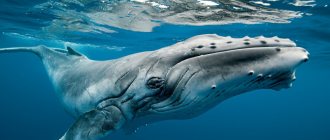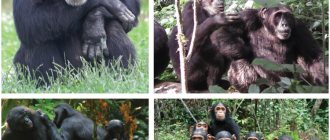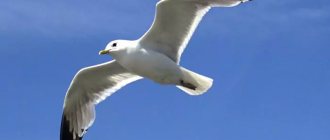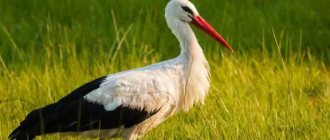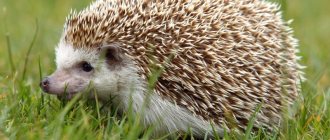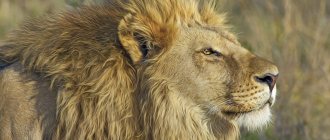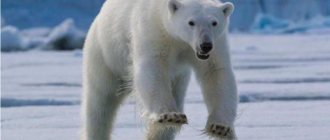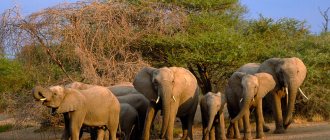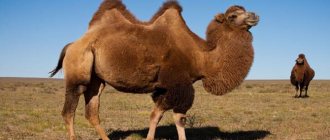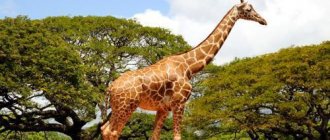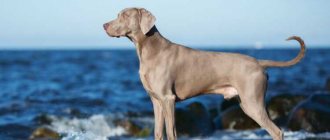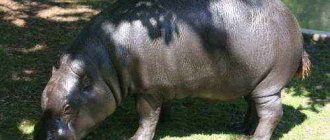The mountain sheep also has other names, such as argali, argali, kachkar, arkar. This is a very graceful animal that lives in the wild. This animal represents the bovid family. Found in the highlands of Central Asia. The mountain sheep is the largest animal of its kind. Despite the fact that experts are still arguing about how many species of sheep there are on our Planet, most of them have identified 7 species. The term “Mountain sheep” is used by some in relation to many species, while others only in relation to argali.
General view of the view
- The body is 1.3-1.9 m long;
- Weighing from 26 kg to 220 kg;
- Height - 65-125 cm;
- The head is medium-sized, elongated, and is decorated with twisted horns, which are more powerful in males. There are hornless species;
- With eye sockets located on the sides, rams have excellent vision of what is happening behind them;
- Well-developed sense of smell;
- Wonderful hearing;
- Domestic sheep have 32 teeth, but wild sheep have different numbers;
- Taste qualities are well developed;
- They have a tail - 8-15 cm;
- The body on slender high legs is decorated with thick fur;
- Wide variety of animal colors.
Lifestyle and habitat
For domestic sheep, the most important climatic factor is not temperature, but air humidity. Any breed can hardly tolerate damp air, but in dry weather they do not mind severe frosts or heat. Thick wool delays solar radiation and allows sheep not to overheat, and in winter it warms them from the cold.
A common “stereotype” is that domestic sheep are stupid animals. Indeed, you should not try to justify all animals and try to find the rudiments of reasonable behavior in them. The size of the sheep's brain does not allow them to exhibit a high level of intelligence even compared to their ancestors ( the wild sheep had a more developed brain).
They make very poor contact with humans and other animals, paying attention only to their flock, have little interest in everything that happens around them, and are the only domestic animals that never even protect their lambs.
At the same time, sheep are very timid and cowardly animals. The sounds of a sheep are called bleating - with the help of it the animal communicates with its relatives, but can also show anxiety and dissatisfaction.
Sheep are animals in which the herd instinct has reached its maximum peak. They are literally guided in everything by the behavior of their flock, and the larger it is, the more comfortable the sheep feel in it. Often they don’t even need to be herded - just tie a ram, leave a dog with the sheep, and they won’t run away.
There are many proverbs that emphasize the gregariousness and stupidity of sheep, for example, “looks like a ram at a new gate” (cannot cope with a new, unfamiliar situation) or “like a flock of rams” (together, together). At the same time, the sheep is a symbol of gentleness and humility, which has found its symbolic meaning in the Christian religion, where God is represented as a pastor (shepherd), and people are his humble flock.
Lifespan
In their natural habitat they live from 6 to 13 years, sometimes up to 15. In a household they live for 8 - 15 years, with proper care up to 20 years.
Note!
- Euthanasia of animals.
- Spitz. Features of the breed.
Car hammock for dogs. What it is?
Nutrition
Sheep, unlike goats or cows, are less picky about their food and pastures. Their incisors are located at an angle to the jaw, as if protruding forward; This structure of teeth allows sheep to eat plants almost at the roots, which increases the efficiency of pastures and makes it possible to stay on them longer.
In the warm season, sheep receive the main amount of nutrients during grazing. Avoid wetlands, or conversely, too dry places for grazing. A forest clearing or a small meadow is perfect, where sheep can eat not only grass, but also young shoots, branches and leaves.
Sheep should not be prohibited from eating weeds (wheatgrass, burdock); they are in no way inferior in nutritional value to cultivated meadow grasses. But it is better not to take sheep to areas where henbane, celandine, datura and other poisonous herbs grow.
Even if everything is fine with the animals, toxic substances can change the taste of the milk, making it bitter and unpleasant. Grazing should be carried out away from gardens and clubs, since some ornamental plants, such as lily of the valley, are poisonous and should not be included in the animal’s diet.
The flock should not be taken out to pasture after rain, since wet grass is poorly processed in the sheep's rumen and can cause sympathy. During this disease, the animal suffers from the accumulation of gases in the stomach, and as a result, bloating.
The reason is that grass irrigated with dew or rain begins to ferment in the digestive tract. Without treatment, sympathy can lead to the death of the animal. Therefore, in early spring, when the grass is still young and juicy, it is recommended to give the sheep hay or straw to balance the moisture content of the diet.
Sometimes the flock is grazed until mid-winter, but the amount of food on the pasture gradually decreases, and the sheep are transferred to additional feeding. First of all, this is harvested hay, especially clover hay, which contains the most protein and microelements, but this is rather the recommended feed for meat sheep.
You can also give sheep silage feed, beet and carrot tops, forage crops such as corn, pumpkins and zucchini (growing vegetables for animal feed is expensive, but sheep love them very much). All year round, regardless of temperature, animals need mineral nutrition.
It is recommended to use feed chalk and bone meal. Sometimes sheep begin to show attention to their owner in an unusual way by licking his hands. This behavior indicates that the animals do not have enough salt and need to add it to the diet.
Sheep breeding
Sexual maturity occurs at 2-3 years. In domesticated animals it is a little earlier; they start mating for the first time at one and a half years.
If rams live in the southern regions, then the mating season begins in July, more northern regions later: October, November and up to December.
Long battles arise between the males for the right to possess the female. Having fertilized one female, the ram looks for a new female. Pregnancy lasts an average of 5 months.
A born lamb weighs from three to five kilograms. One female may give birth to one or two lambs at once, sometimes three.
The mother feeds the lambs milk for three or four months, although they can immediately consume plant foods. After six months it is already an independent animal.
Description and features
Sheep are one of the most common farm animal species. Sheep farming is practiced in almost all countries of the world, but the largest population is found in Australia, New Zealand, Great Britain and the Middle East. The main product of this livestock industry is wool, but sheep are also bred for meat, milk and leather.
The process of domestication of sheep began approximately 8-9 thousand years ago with their closest relative, the mouflon, which lives in the mountains of Central Asia and Southern Europe. Sheep and goats were domesticated before cattle, as they are more unpretentious in the maintenance and quality of pastures. Around this time, man domesticated the dog, which expanded sheep farming and helped herd animals.
Over the entire history of sheep breeding, more than 100 breeds have been bred for various purposes, and they all have their own characteristics, but in general terms, sheep are medium-sized artiodactyl animals with curly, curled hair. The height at the withers is up to a meter, weight can vary greatly among different breeds, on average females weigh 50-100 kg, males are slightly larger - 70-150 kg.
The sheep in the photo on the Internet most often has a white color, but there are breeds of sheep with brown or even black wool. Both sexes have horns, but in sheep they are very weakly expressed. Rams' horns curl in a spiral and can reach a length of one meter.
East Friesian breed
The East Friesian breed comes from Germany. It is universal. It is valued for its meat, lard and wool.
Eastfriesian sheep are large in size. They have a curved nose line and no fleece on their head and thin tail. Long ears point towards the nose. The chest and back are wide, drooping croup. Eastfriesian sheep have well-developed muscles. The coat is painted white.
Sheep of this breed are not distinguished by their endurance and do not tolerate climate change well, but if a purebred sheep is crossed with a local breed that has endurance, it will be possible to increase the level of endurance and acclimatization.
Productivity indicators
The weight of an adult ram is 115 kg. Queens weigh 30 kg less. By 12 months, the Friesian sheep practically reaches its maximum weight, which allows us to classify this breed as early maturing. Daily growth with proper care and quality nutrition exceeds 300 g.
The wool harvest is 6 and 4.5 kg per ram and sheep, respectively. The fleece is short and soft to the touch. The net yield of fleece is 70%. Milk productivity - 650 kg per lactation. Some farmers breed East Friesian sheep specifically to produce milk with a fat content of 6.5%.
Tashlin breed
The Tashlinsky breed was bred in 2008 by livestock specialists of the Stavropol region. These are meat rams, but Tashlinsky sheep have excellent quality fleece and high milk productivity. Farmers also note the fertility of Tashlin queens.
Representatives of this breed do not have horns. They are well built, their shape corresponds to the meat orientation of the breed.
Productivity indicators
Meat productivity is 96 and 60 kg for rams and sheep, respectively. Lambs are gaining weight well. The daily gain during the first 5 months is 200-220 g. Sometimes the weight gain reaches 400 g per day. But such results can only be achieved by organizing proper nutrition.
Wool productivity is 6.5 kg for rams and 4.5 kg for sheep. At the same time, the net yield is more than 60%. The length of the fleece of the Tashlin sheep is 115 mm. A flock of 100 queens produces a litter of 160 lambs and is bright.
It is advantageous to slaughter lambs at 9 months of age. This is due to the fact that the percentage of meat and bones during this period is 80 to 20.
Interesting facts about the animal
- The weight of the horns can reach up to 30 feet.
- Another name for the snow sheep is chubuk. This word also refers to part of a smoking pipe and one of the districts of Ankara.
- The sheep's long intestines allow it to eat a lot of vegetation.
- The horns of the animal are a gorgeous trophy, and the meat is a delicious dietary product. Lamb is used to make shish kebab. The most delicious is young lamb tenderloin, which goes well with vegetables, legumes and mushrooms.
- Due to cold and lack of food, 30-50% of young animals die in the first year of life.
- Bighorn sheep meat contains vitamins A, E, B and PP, iodine, calcium, potassium, magnesium, phosphorus and iron. Its use strengthens the digestive and cardiovascular systems.
- Previously, animals lived next to humans. Bighorn sheep were hunted only for their valuable fur. The Chukchi used it to sew clothes for children. Preying on a female was severely punished.
- In 1989, Chubuk was brought to the Novosibirsk Zoo. Later, young animals were born, which were transferred to other institutions for keeping animals in captivity.
- The bighorn sheep is called the Spartan of the mountain tundra. He lives next to musk ox and reindeer under conditions of poor food and harsh climate.
Karakul breed
The Karakul breed of sheep is one of the most ancient meat varieties. It is bred in many European countries, Africa, America and Asia. In addition to delicious meat, sheep have excellent skin. The Karakul sheep appeared thanks to the work of breeders from Uzbekistan. A special feature of this breed of sheep is the presence of a long tail, but the rams do not straighten it, so it hardly reaches the hock joints.
If we talk about the features of the exterior, the karakul is a hump-nosed ram with ears of medium length. The massive body is supported by thin limbs that end in powerful hooves. The head, legs and neck are covered with short hair, colored black. Over time, most fur, regardless of its original color, becomes gray. Livestock breeders characterize the depigmentation process as graying.
The wool of astrakhan sheep can be dyed black or gray. About 10% of sheep have a sur color. About 4% of sheep are white or brown. Sometimes there are individuals with pink fur.
Productivity indicators
In addition to wool, Karakul sheep are valued for their tasty meat. Meat productivity is 65 kg for rams and 45 kg for queens. The weight of a newborn lamb rarely exceeds 4.5 kg. Lambs quickly gain weight, which is an advantage of the breed. Excellent sheep cheeses are prepared from rennet obtained from 1-2-day-old lambs and sheep's milk. Livestock farmers also make money from sheep wool. It is possible to shear about 4 kg of wool from sheep per year. On average, 3 kg of wool is shorn from sheep.
Fertility is another important characteristic for livestock farmers. A flock of 100 ewes produces 140 lambs annually.
Vyatka breed
Disease-resistant breed
The Vyatka breed was born thanks to the work of Russian livestock specialists. During the selection, the Soviet Merino and Prekos breeds were used. This is a large meat-wool sheep. It looks massive and has a square format. The advantages of the breed include resistance to many diseases, adaptability to difficult climatic conditions, unpretentiousness in food, and precocity. The head is covered with thick and long hair. The short nose is not curved, the ears protrude to the sides.
Productivity indicators
The weight of an adult ram reaches 1 quintal. A sheep weighs 50 kg less. If we talk about maximum productivity indicators, then it is 140 and 80 kg for rams and sheep, respectively. The meat is valued for its taste. It can even compete with marbled beef.
Sheared wool from a ram - 6 kg. The female produces 2 times less high-quality fleece. Some individuals produce 12 kg of wool per year. The length of the fleece is 8.5 cm. The yield of fleece after cleaning is 55%. A herd of 100 queens produces a litter of 140 lambs with strong immunity.
Vyatka sheep are popular in Russia and Ukraine.
Dairy
East Frisian: this sheep produces milk of the highest standard. A herd of individuals is capable of producing milk up to 700 liters per day, the BJU of which does not exceed the norm of the human body.
Lacayune: sheep of this species produce high-quality and high milk yield with a low fat content of 8%.
Awassi: Thanks to increased immunity and endurance, the sheep is able to withstand low and high temperatures. Their milk always comes out homogeneous, without any signs of lumps. Caring for an individual is not particularly difficult, since the animal is unpretentious and is able to drink only 2 times in 7 days.
Latvian dark-headed breed
The Latvian dark-headed sheep breed is the result of the work of Latvian livestock specialists, whose goal was to obtain highly productive meat rams. They did not quite cope with this task, since the meat productivity indicators are average. The breed has become widespread not only in Latvia, but also in Russia.
As for the exterior, the animals have good meat shapes and a strong constitution. They look quite elegant for their weight, thanks to their thin bones. The short and fairly wide head is connected to the body by a short neck. To match their heads, rams have a wide back and the same chest, going deep. The body is supported by widely spaced straight limbs. The predominant color of the fleece is up to 9 cm long. Sometimes there are individual hairs dyed in other colors.
Productivity indicators
The live weight of rams is 1 quintal. An adult dark-headed sheep weighs about 60 kg. This is an early maturing breed. Lambs quickly gain weight due to the high milk productivity of the queens during lactation (about 180 kg of milk). The net yield of meat after slaughter is 60%.
Fertility of queens is 170 lambs per 100 queens. Trimmed - 5 and 3.5 kg for rams and sheep. After processing the shearing, up to 55% of high-quality wool remains. Based on productivity indicators, the Latvian dark-headed breed is classified as a meat-and-wool type.
Buubey
Sheep can live outdoors
Buubey is a meat breed whose homeland is Buryatia. This Buryat sheep is also valued for its high quality fleece. Buubey lambs tolerate low temperatures well. They are suitable for pasture keeping. It is enough to build a canopy on the site that will protect the animals from natural precipitation and strong winds.
Buubei are well built, with a large body and thin legs. The body is rectangular in shape and ends with a short tail. The head is neat, the nose line is curved. The fleece is colored white and consists of down and axial hair. At the same time, in percentage terms, down accounts for 80% of the total wool.
Productivity indicators
Meat productivity is 95 kg for rams and 55 kg for sheep. This is an early maturing breed. In the first 7 months of life, lambs gain 40 kg. If we talk about the net yield after slaughter, it is 50%. Meat without the specific smell inherent in lamb.
Wool productivity is low. It is 1.5 and 1 kg for rams and ewes, but the resulting wool is of high quality. Its length reaches 20 cm. As for fertility, Buubey has high rates. A flock of 100 sheep produces an offspring of 95 heads. It is also difficult to find a sheep that has more developed maternal instincts than the Buubei breed.
